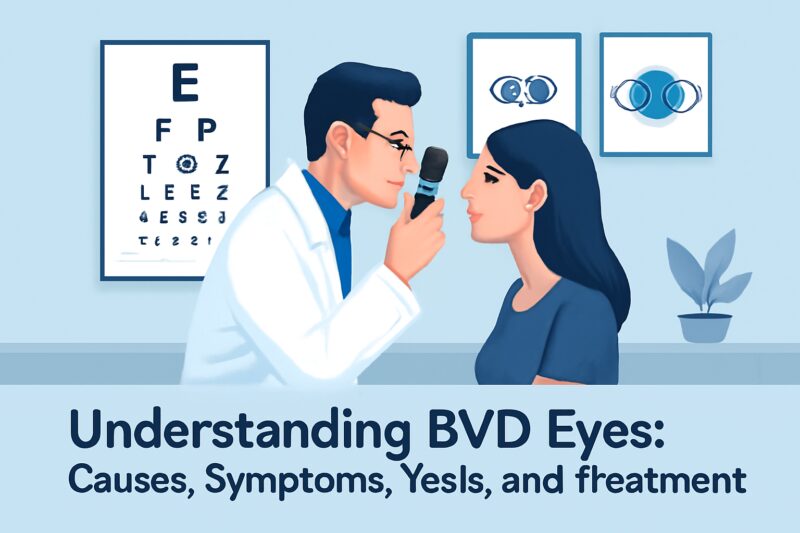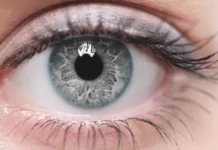Understanding BVD Eyes: Causes, Symptoms, Tests, and Treatment of Binocular Vision Dysfunction
BVD Eyes: If you’ve been experiencing unexplained eye strain, dizziness, headaches, or difficulty focusing, you might be dealing with a condition called Binocular Vision Dysfunction (BVD), often referred to simply as BVD eyes. Many people suffer from this underdiagnosed visual disorder that affects how your eyes work together.
In this extensive guide, we will cover everything you need to know about BVD eyes: what it is, how to recognize symptoms, the methods used in a BVD eye test, and how to find the right BVD specialist or eye doctor near you for diagnosis and treatment.
What is BVD Eyes? – A Clear Explanation
BVD or Binocular Vision Dysfunction is a condition where your eyes have difficulty aligning correctly when working together. Normally, your eyes move in perfect sync to create a single image. However, with BVD, misalignment occurs that causes your brain to receive conflicting visual information. This leads to symptoms such as eye strain, blurred vision, dizziness, and discomfort.
What is BVD on Eye Test?
During a BVD eye test, eye care professionals measure your eyes’ alignment and coordination. This specialized test goes beyond a regular vision exam, focusing on how your eyes move together and whether they compensate for any misalignment. Many patients searching “what is BVD eye test” want to understand what to expect — it typically involves assessing eye posture, movements, and the patient’s binocular fusion capacity.
Causes and Risk Factors of Binocular Vision Dysfunction
Several factors can contribute to the development of BVD eyes:
-
Head trauma or concussion: Injuries involving the head or brain often disrupt eye coordination.
-
Strabismus: Known as crossed eyes, this is a direct cause of binocular vision issues.
-
Incorrect glasses or prescriptions: Wearing wrong prescription glasses can worsen eye alignment.
-
Poor posture or prolonged screen time: These can induce eye strain and exacerbate BVD symptoms.
-
Developmental issues: Some people are born with binocular vision discrepancies.
Understanding the cause can help with prevention and guide effective treatment methods.
Common Symptoms of BVD Eyes
Recognizing the symptoms is key to seeking timely help. If you have BVD, you may notice:
-
Persistent eye strain and dizziness
-
Headaches, especially after reading or screen use
-
Difficulty concentrating or focusing on objects
-
Double vision or blurred vision
-
Neck and shoulder pain caused by compensatory posture
-
Sensitivity to light
-
Feeling off-balance or nauseous, sometimes mistaken for vertigo
If you identify with these symptoms, it’s worth consulting with an eye care specialist for a comprehensive evaluation.
How to Test for BVD Eyes: Understanding the Eye Exam
When you visit an eye specialist concerned with BVD, expect a detailed visual function test. Common testing steps include:
-
Cover tests: to detect eye alignment issues.
-
Vergence testing: measures how your eyes move inward and outward.
-
Phoria measurement: identifies latent deviations in eye positioning.
-
9 Point BVD Eye Test: a diagnostic test specific for binocular vision dysfunction.
-
Symptoms questionnaire: helps correlate visual abnormalities with symptoms.
Many patients who ask “how to test for BVD eyes” want assurance that this condition is diagnosable — eye doctors trained in binocular vision care will use precise tools for this purpose.
Finding a BVD Eye Doctor Near Me – What to Look For
If the keyword “BVD eye doctor near me” reflects your intent to find professional help, here is what you should consider:
-
Look for an optometrist or ophthalmologist specializing in binocular vision therapy.
-
Verify their experience with BVD and vision disorders relating to eye alignment.
-
Read reviews or ask for patient testimonials.
-
Check for access to advanced diagnostic tools for binocular vision dysfunction.
-
Some clinics advertise “BVD specialist near me,” meaning professionals trained specifically in treating this disorder.
It is crucial to receive diagnosis and treatment from a knowledgeable eye specialist who understands the nuances of BVD.
Treating Binocular Vision Dysfunction – Therapy and Solutions
The good news is BVD is treatable. Some of the most effective treatment options include:
-
Vision therapy: A series of eye exercises designed to improve eye coordination and alignment.
-
Prism glasses: Specialized lenses that help realign the visual input to your brain, reducing symptoms.
-
Correct prescription updates: Accurate glasses or contact lens prescriptions can alleviate symptoms.
-
Postural training: Since posture impacts vision, some cases benefit from postural correction.
-
Regular follow-ups: Monitoring progress and adjusting therapy ensures optimum results.
Patients often report significant relief from symptoms like dizziness and eye strain after receiving proper treatment.
What is BVD in Eyes? FAQs
Q: What does BVD stand for in eyes?
A: BVD stands for Binocular Vision Dysfunction, a condition where your eyes do not align properly, causing visual and neurological symptoms.
Q: How serious is BVD eyes?
A: While BVD does not cause permanent eye damage, untreated symptoms can greatly affect quality of life through persistent headaches, dizziness, and difficulties with focus.
Q: Can BVD be detected in a regular eye exam?
A: Not always. Regular eye exams usually check visual acuity but may miss binocular vision problems. A specialized BVD eye test by a trained specialist is recommended.
Q: How long does vision therapy for BVD take?
A: Vision therapy length varies by individual but often ranges from a few weeks to several months depending on the severity.
Q: Is BVD common?
A: BVD is more common than many realize, often underdiagnosed because symptoms are mistaken for migraines or inner ear issues.
The Link Between BVD and Eye Strain, Dizziness, and Nausea
Because BVD disrupts your brain’s ability to fuse images from both eyes correctly, it causes sensory confusion leading to:
-
Eye ache and dizziness
-
Motion sensitivity
-
Nausea and even balance problems
This is why many people with BVD are misdiagnosed with vertigo or other neurological conditions before their eye condition is discovered.
Conclusion: Don’t Ignore Your Vision Symptoms
If you frequently experience headaches, dizziness, or persistent eye strain, especially after reading or screen use, it’s important not to dismiss these symptoms. BVD eyes or binocular vision dysfunction could be the underlying cause.
Early diagnosis through a proper BVD eye test and intervention by a qualified BVD specialist near you can vastly improve your quality of life. Treatment options like prism glasses and vision therapy have proven success in alleviating symptoms.
Take control of your visual health today by consulting an eye care professional experienced in binocular vision disorders.



